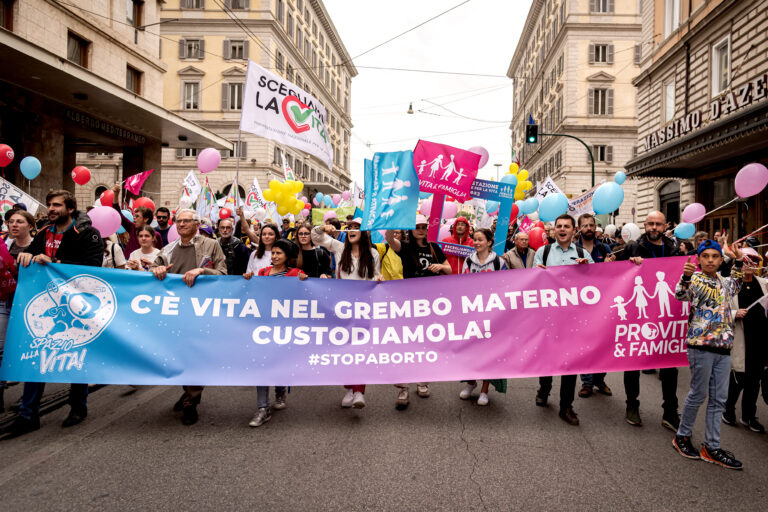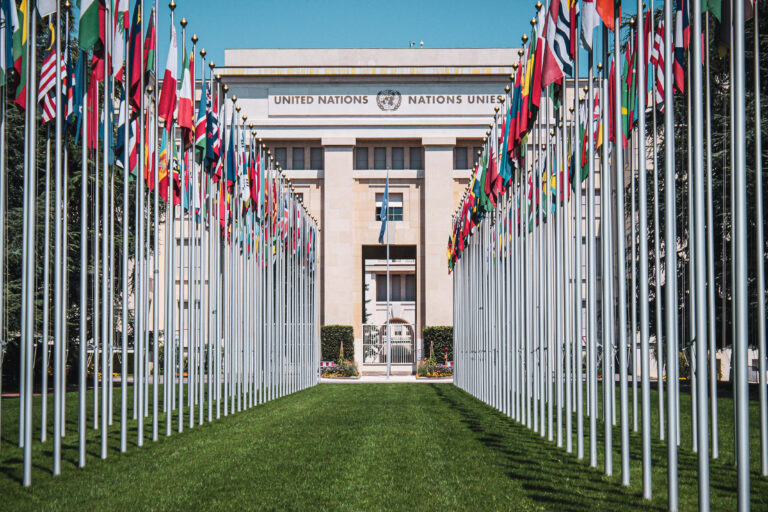Subcommittee Investigation of Persons and Institutions Involved in Voluntary Surgical Contraception
Date of Publication: June 2002
“Precisely because the system of population control was used to eliminate poverty, we believe that we must raise the people from their poverty by means of education and health.”
— Mr. Christopher Smith, Congressman of the United States to the Investigative Subcommittee, March 2002.
During the plenary session of Congress, October 25, 2001, the formation of the Investigative Commission Concerning Alleged Irregularities and Violations of Fundamental Human Rights by Acts of Voluntary Surgical Contraception (VSC) [Anticoncepcion Quirurgica Voluntary (AQV)] during the Preceding Government of Alberto Fujimori, was approved because of the Motion, presented by Congressman Hector Chavez Chuchon for the Day’s Agenda, Number 501.
I. Antecedents
Charter of the Subcommission: investigate the alleged irregularities and violations of the basic human rights of the people by the application and actions of voluntary surgical contraception during the previous government of ex-President Fujumori.
The charter of the Subcommission runs 120 days from 15 February 2002 until 15 June 2002, which was extended until 30 June.
The scope of the investigation includes calling upon ex-ministers of health of said government, visits to various locations in the interior of the country where VSC was practiced, meetings with various people and representatives of institutions who had direct connections with VSC sterilization campaigns, investigative material, compilation of documents from private and public institutions, as well as denunciations from various people.
II. Legal Base
The present investigation is made within the authority that article number 97 of the Political Constitution of the State gives Congress of the Republic, saying verbatim:
Article number 97:
The Congress can initiate investigations about any subject of public interest. It is obligatory to appear, after being requested to do so, before the Commissions in charge of such investigations, under the same rules that are observed in the judicial process.
For the fulfillment of their goals, these commissions can have access to any kind of information, which can include the lifting of the banking secrecy and of the secrecy of the office in charge of the collection of taxes, except information about very intimate personal questions. Their conclusions are not obligatory for the jurisdictional organisms.
Application of Voluntary Surgical (VSC) to the Population Policy
The new population program, inaugurated 28 July 1990, rapidly put into execution a new population policy, which became known as the National Population Policy 1991–1995 and was effected by the Technical Sectoral Committee. This program established phases of demographic policy, as well as new methods to accomplish its goals. Soon after the Interministerial Committee of Economic Affairs [CIAEF] approved the program, which subsequently became the policy of the Peruvian government.
Among the eight specifically-designed programs of the new National Population Program, precedence was given to “Reproductive Health and Family Planning,” and to “Decentralization of the Population Policy,” with special emphasis on rural zones, the jungle and the mountainous areas of Peru.
Women of rural areas maintain their patterns of reproduction at a high level. The rates of fecundity are more than double that in Lima-Callao
The new program also proposed as a specific objective “to reduce the rhythm of natural increase of population to no more than 2% by 1995, giving a drop in fecundity. The rate of fecundity may not exceed 3.3 children average per woman for the decade.”
Sexual conduct must be regulated through a “Program of Reproductive Health,” since it was qualified by UNFPA as a high risk because “high fecundity by itself is related to high rates of sickness and death.”
Human groups of women: Women of fertile age, those residing in the poor regions of the Andes and the Peruvian jungle, and of marginal sectors.
Fulfilling goals for the period 1990–1995
The personal participation of the ex-President Alberto Fujimori who in his message to the nation on July 28, 1995 said: “I would be hypocritical … knowing that different methods are used for different social classes. The right thing is to disseminate thoroughly the methods of family planning … we will be a pragmatic government, without taboos, nor sacred cows … women will be the masters of their own destinies.”
He sent to Congress an urgent request to change the former law that excluded sterilization as a method of family planning.
The ex-President eliminated this ‘obstacle’ by submitting to Congress a statute for passage that would legalize sterilization. Sterilization and abortion are procedures for birth control recommended by international organizations, as we shall detail later.
The Fujimori government sent a statute for approval, 155/95-CR, proposing the legalization of sterilization as a method of family planning. The submission requested that it be acted upon on an emergency basis, as provided for in the Constitution for exceptional cases.
Irregularities in the application of VSC
The National Law of Population eliminated the restriction on sterilization as an accepted method of contraception, and constituted a new phase emanating from the health sector in the massive and aggressive campaigns according to which sterilization [ligation of fallopian tubes for women and vasectomy for men] became the accepted norm for the poorest parts of the country. Many deaths resulted from serious irregularities arising from malpractice and absence of consent among the victims.
Legal Base: The Peruvian Constitution declares that “The defense of the human person and the respect of its dignity are the supreme goals of Society and the State.”
The National Population Policy has as its objective the promotion of responsible parenthood. It recognizes the right of families and persons to decide for themselves.
Article 7: Everyone has the right to protect their health, within the family and within the community, as well as the right to contribute to its promotion and preservation.
Violation of the constitutional right of free election and no discrimination and Denunciations by institutions and organizations of the right to choose a method of family planning
Organizations cited throughout the Report: Defensoría del Pueblo (Defenders of the People ), Cladem (Committee of Latin America and the Caribbean for the Defense of the Rights of Women), Conferencia Episcopal Peruana (Peruvian Conference of Catholic Bishops), Subcommission of Inquiry of VSC, Colegio Médico del Perú, Congress of the Republic
The National Population Program specifies in article 36: “Professionals and their medical assistants and technical personnel are responsible for damages and liabilities occasioned by negligent or imprudent services to the patient.”
Free choice of contraceptive methods is a constitutional right as specified in Article 6.
It is the responsibility of the counselor that the patients make a free, voluntary and responsible decision, about their fecundity, that they know the benefits and the risks of all the contraceptive methods available, and in case of the VSC, of the irreversibility of the method.
Denunciations from institutions and organizations about the violations of the constitutional right to choose the method of family planning
Defensoría del Pueblo:
“The right of freedom to choose requires that people be informed about all the legal methods of family planning, including their benefits and risks, to have free access to them, and to have sufficient guarantees to be able to use them or to reject them.
From investigations and the testimonies collected it was found that a percentage of women using VSC did not have access to all the information available and if there was some information it was in the form of brochures and without prior counseling. Also that the counseling was insufficient: ‘… because many were not informed of all the contraceptive methods. Also there was not enough of an interval before the women consented and the surgical intervention took place, making doubtful all possibility of considering with serenity a decision to adopt an irreversible method or other temporary ones available to the population.”’
Cladem:
“Besides the cases of forced sterilization, we found a greater number of cases that describe the manipulations, biased or incomplete information, absence of guarantees in the process of decision, threats and ill treatment contrary to the self image of the person, and the capacity to dissent of the persons that were to be sterilized. The women were refused the contraceptive method of their choice.”
“There was no information, verbal or written, about the characteristics, risks, and post-surgical precautions and/or deceitful information about the character of the intervention.”
“There was an absence of counseling where the woman would receive information about the various contraceptive methods, plus the absence of a period of time to make a well-considered decision.”
Congress of the Republic:
“It is necessary to mention that already in 1998 it was mentioned in the Peruvian Congress what was of public knowledge from the newspapers El Comercio and Republico about the supposed irregularities in the application of VSC.”
Conferencia Episcopal Peruana:
“Women, especially from the mountains and the poorer sectors of the population, were being forced to submit to VSC under the threat of losing help from the food programs. Also those performing massive sterilizations were taking advantage of the ignorance and docility of the population, sometimes from house to house, and village by village.”
Colegio Médico del Perú [Medical College of Peru]:
“The health personnel must be able to know how to counsel the persons or couples about their reproductive health, in order that they may be able to have the number of children they want and facilitate access to family planning, if that is their decision.”
Right to no discrimination
Legal Base: Article 2, number 2, of the Constitution of 1993: “Every person has the right to equality before the law. No one can be discriminated against by reason of origin, race, sex, language, religion, opinion, economic conditions or any other reason.
Article 3 (paragraph 2) of the Convention of the OIT No. 169 about the indigenous peoples: “One cannot use any kind of force or coercion that violates the human rights and the fundamental liberties of the interested people.”
Cladem:
“The program is oriented towards women in extreme poverty, indigenous women. The authorities promote irreversible methods exclusively.”
“Cladem has observed discrimination by gender, by socio-economic conditions (poverty and extreme poverty), by origin, racial and/or ethnic-linguistic conditions. There also has been found evidence of abuses against specific groups, populations with disabilities, or with pulmonary sicknesses.”
Defensoría del Pueblo:
“The Program of Reproductive Health established goals to apply only to women in the fertile ages … discriminating against women, because the program must be directed also to men.”
Denunciations by institutions and organizations about the violations of the right to health by abandonment of patients in the post-surgical period
Cladem:
“A considerable number of our interviews found women that presented previous problems of malnutrition, anemia, chronic pelvic infections, sickness in the reproductive tract that should have been taken into account in order to have better conditions for the surgical interventions. We have observed conditions among the population of the Andes with constant references to nervousness, anguish, headaches, aggressiveness that the patients said were caused by the tubal ligations, conditions which have lasted for several months.”
Colegio Médico del Perú:
“The follow up and control after the surgical intervention has been deficient or non-existent in some clinics, especially in the rural areas. The medical personnel just went away after the operation without taking care of the follow-up with the patients, and the possible complications. Besides, many clinics did not have services 24 hours of the day.”
The establishment of numerical goals, and/or incentives to fulfill the quotas of patients
“… These goals should not be enforced upon the providers of the services of family planning. . .”
Cladem:
“In November 1996 we obtained proof that there were quotas for VSC: In the clinic of Huacabamba, a document mentioned a quota of 395 VSC’s for 1996, saying that they had fulfilled already 42% of their goal, the equivalent of 143 tubal ligations and 26 vasectomies. The testimony of a medical student, whose professor demanded that he should find two people to perform VSC’s on, and that would fulfill 3% of the student’s final grade.”
Festivals and Campaigns designed solely to promote tubal ligations and vasectomies
These took part all over Peru, with activities like sports, theater, dances, musical bands, fireworks, competitions of murals with health themes, etc.
Conferencia Episcopal Peruana:
“… After the law was approved … the first step was to promote sterilization as a contraceptive method by means of Health Festivals (Festivales de Salud) promoting free sterilizations. Not only promoting them, but for the most part, the women were pressured, taking advantage of their little understanding of the matter.”
From the General Law on Health, section on Authorized Legal Consent, Article 4: No individual may be subject to medical or surgical treatment without the prior consent of the person legally authorized to give the consent.
Article 5: Every individual has the right to be duly and properly informed by medical authority concerning medical procedures of diet, hygiene, mental health and reproductive health.
Article 6: Every person has the right to elect the contraceptive method of their preference, including natural ones, as well as to have been fully and adequately briefed on the prescribed contraceptive method, its risks, contraindications, necessary precautions and warnings and side effects, be they physical, physiological or psychological, which their use might occasion.”
The requirement of the written consent or application for the intervention of the Voluntary Surgical Contraception as a requisite before the operation
The consent of the spouse was not required, but the signatures of the patient and of the doctor or obstetrician were required.
The second edition of the Manual of Norms and Procedures for VSC establishes a 72-hour waiting period be ginning with the moment of signing the Authorized Consent Form.
Cladem:
“There were irregularities … lack of written consent, refusal of the desired method if it was not sterilization, recommendation of sterilization as a short lasting opportunity, announcing that the reversible methods were not being offered, lack of information, written or oral about the post-surgical risks, and/or deceiving information about the character of the intervention.”
Forced sterilizations and/or performed under threats or deceit
Conferencia Episcopal Peruana:
“In Piura, Jaime Monzón Tejeda complained that his wife died after a sterilization. She was constantly pressured by the nurses, who said that the operation was quick and painless. She died 22 days later of asphyxia in the brain. (Newspaper El Comercio, 1/24/98.)”
Cladem:
“G. H. C., 28 years old, from Totora … farmer, with three children, illiterate, was operated on in August 1997 in the clinic of Izcuchaca. According to her testimony, the health workers came to her house and forced her to undergo the operation. She said, ‘I did not want it because my husband was not at home, but they took me by force at seven in the morning. I wanted to escape from the hospital, but they did not let me go.’ They told her that she was going to receive some food. She did not sign anything.”
“M. A. Q., 33 years old, declared that she was taken to the Support Hospital at Huancavelica, with the pretext to apply on her an ampoule. Even when they tried to force her to sign an authorization for the operation, she did not do it. Nevertheless the health personnel put pressure on her husband, who signed for her. She underwent a ligation of the fallopian tubes on January 10, 1997 against her will.”
“Testimony of H. H. H., a Quechua farmer from Anta who was sterilized without her consent, who stated: ‘I cried in front of my husband. Why did they do this to me? What if I become sick? Seeing me so, my husband asked the nurse, ‘Miss, since you did this to my wife, what should I do in case she becomes ill?’
Then the nurse said: ‘You had better be grateful that the government of Fujimori has ordered this help so that you stop begetting children without number. President Fujimori has ordered this help to three hundred mothers of the Pampa Anta. Are we trying to cut the throats of people? Any private doctor would have charged you more than 300 soles.’ Saying that, they sent us away.”
Participation of International Organizations in the Financing and Application of the Programs of Family Planning made by the Government in the years 1995–2000
The population policy followed by the Peruvian government was induced and financed by international organizations, namely USAID [United States Agency for International Development] and UNFPA [United Nations Population Fund]. These restrictive [population] policies from outside the country carried with them not only financing but also demographic objectives which translate into targeted reductions in the fertility of Peruvian women, emphasizing those in our poor areas. In particular, this international aid included medical and surgical instruments to carry out VSC and a variety of contraceptive [devices and drugs].
These policies were proposed to the Peruvian government before the period 1995–2000.
International aid proposed to the Peruvian government concentrated preferentially on meeting demographic objectives, especially since the inauguration of the government of ex-President Alberto Fujimori. These objectives were incorporated into the National Population Program of 1991–1995. In an unprecedented case in the national legislation, the Technical department of that Program was given to an international organization, like UNFPA.
Intervention and participation of international organizations cited concerning the National Population Program extended to the organization and structure of the Peruvian family through NGO’s, publicly and notoriously funded by USAID and UNFPA.
International Expenses and Number of VSC’s
The presentation of Dr. Jorge Parra Vergara, former Director of the Program of Reproductive Health and Family Planning shows clearly that the majority of the VSC’s were closely related with the larger financial amounts from USAID.
We think that this correlation has a natural cause, given that information exists that was recently made public revealing the global strategy defined in the last quarter of the 20th century by the government of the United States having the object of lowering the birth rate down to the replacement level by the year 2000. This was expressed in the so-called Kissinger report, put together from responses by various agencies of the government of the U.S. to the National Security Study Memorandum (NSSM 200), dated 24 April 1974, NSSM 200 whose theme is Consequences of Population Growth for the Security of the United States and its Overseas Interests, was directed to the Secretary of Defense, Secretary of Agriculture, the Director of the CIA, Secretary of State and the Administrator of the Agency for International Development.
Several authors have compiled abundant information about the meddling of USAID in underdeveloped countries to influence their economic policies with arguments of demographic type, and vice versa. The economist Julian L. Simon in his book The Ultimate Resource shows the lack of truth of using the measures of demographic control promoted by USAID directly or by means of several NGO’s to alleviate the poverty of the third world countries.
Nevertheless, it seems that this information never reached the ex-President Alberto Fujimori. Several times he announced that he would fight against poverty by promoting contraception among the poor. Even by 1990 that expression was not used by the more recalcitrant defenders of birth control, because it had been widely proven that the decrease of births by itself would not bring any change in the level of poverty.
Another important document was published by E. Liagin with the title “USAID and Involuntary Sterilization in Peru” in which she analyzes the action made between 1995 and 1997. According to her “the internal archives of USAID show that in 1993 the United States basically took charge of the national health system of Peru… The bilateral accord of 1993 that put the United States in such advantageous position, known as ‘Project 2000,’ was signed by the Peruvian and American authorities in September 1993 and was effective for seven years, ending in 2000. An examination of this document shows that USAID-PERU, the office in Lima of AID, was in any conceivable form in control of the Peruvian health sector, before and during the years that the abuses took part.”
Direction
Although on paper the program was a task of the Peruvian government, USAID put great emphasis in the training of officers and personnel of the Health Ministry.
Several times AID has tried to distance itself from the activities of sterilization, but it is well-proven that it has always contributed with the financing of the activities of the AVSC (Association for Voluntary Surgical Contraception.)
In 1996, the then-Director of USAID Peru, George Wachtenheim, clearly stated in the name of his institution that in 1995, USAID had in Peru a project to reduce Peruvian women’s fertility. He said, “regarding family planning, we will work in the most depressed areas. $15 million, half of which goes to the government and the other half to NGO Manuela Ramos, with whom we are working in ‘punctual’ areas, such as Puno, Ayacucho and Apurimac.” Beginning in September 1995, the Family Planning Program supported and financed by this North American organization involved in sterilization brought about literally hundreds of complaints regarding the [absence of] informed consent as called for in Peruvian law. This same ex-director of USAID pronounced in almost triumphal terms, “the birth rates have been brought down from 3 to 2% in the country [of Peru] but in rural areas the figures are seven children per woman, which is impressive but it is necessary to fight on, focusing on these [rural] areas.” His use of the term ‘punctual’ refers to areas where [traditional] family structure is culturally and economically important.
The IX census of 1993 permits us to establish, using the birth rate by department, a projection for the year 2005 which shows that 18 provinces will have a replacement rate less than unity, and therefore candidates for extinction of their population’s self-maintenance. Thus the process of depopulating, due to emigration, and depopulation, due to insufficient reproduction along with an absolute decline from sterilization, begins. International agencies have given generous aid, both financial and technical for Family Planning, and far less proportionately to maternal/child health.
PARTICIPATION OF OTHER ORGANIZATIONS
The UNFPA (United Nations Fund for Population Activities )
Since the beginning of the activities of Family Planning in Peru, the UNFPA has participated together with AID in practically all the activities that contributed to the financing. It is important to take into account that the main contributor of the money for the UNFPA is precisely the United States.
The Nippon Foundation
As soon as the economic contribution of USAID to the activities of the Reproductive Health diminished, following complaints made to the Congress of the United States, President Fujimori looked for other sources of financing, and found the Nippon Foundation.
ACTIONS AND INVESTIGATIONS MADE BY THE SUB-COMMISSION OF INQUIRY OF VSC
Participation of USA Congressman Christopher Smith
Dr. Christopher H. Smith: “Personally I became very suspicious at the Beijing Conference on Women when President Fujimori announced in big New York Times headlines, that he was going to gain control of the population in Peru, and an important part of this work, and other nations as well noted that some were using population control to fight poverty, and that the U.S. was not immune to this system. Precisely it happens that [instead of] using population control to eliminate poverty, we believe that people will be lifted out of their poverty through education and health, not by killing undesired children.”
Case Number 1: Julia Pacco Aymas
from Abancay
Age: 36 years old
File number: 98-137-030101JP02
According to the denunciation before the Office for the Defense of the Rights of Women, it states that the patient was operated while 22 weeks pregnant. The patient did not give authorization for the ligation of the fallopian tubes.
Because of her state she could not be treated further.
Condition: She doesn’t pronounce words that are understandable, she only utters repetitive sounds, and makes signals and movements that cannot be understood. She has lost movement in the right side of the body.
(Letter that arrived to the Congressional Commission of Human Rights.)
Case Number 2: Alejandra Aguirre Auccapiña
from Acobamba
Age: 38 years old
Died as a consequence of the ligation of the fallopian tubes.
Published in the daily newspaper El Comercio, on March 4, 1998.
Case Number 3: Juana Rosa Ochoa Chira
from Huaytará
Age: 33 years old
Died 38 hours after she was sterilized.
Case Number 4: Rufina Aparco Escobar
from Huancavelica
Age: 22 years old
Date of the intervention: November 1998.
She went into the gynecological surgical operating room to have a cesarean section. Anguished because of her pain, she signed an authorization for the operation without knowing that she was authorizing a tubal ligation. It was her second child. He died three hours after being born.
Case Number 5: Gregoria Condori Riveros
from Huancavelica
Age: 40 years old
Date of the intervention: December 14, 1998.
After giving birth inside a vehicle while she was being transported from her community to Huancavelica, she had a retention of the placenta. She was taken to the hospital. Dr. Jorge Fuentes told her that he must perform a Fallopian tube ligation so that she would not have any more children; she and her husband were opposed to that. But when they were taking her to the operating room they made her sign a blank form of authorization for the operation. The next day she realized that she had a cut in the navel, and that she had had a ligation without knowing it.
(This case was reported the Office for the Defense of the People, at the beginning of 1990).
Case Number 6: Julianna de la Cruz Quispe
from Ambato, District of Yauli, Province of Huancaveliea
Age: 45 years old
Date of the intervention: November 12, 1997.
Diagnosis for the intervention: Intestinal obstruction.
Operation performed: Tubal ligation.
Surgeon: Dr. Jorge Fuentes Avila.
There is no authorization for the ligation.
Case Number 7: Sonia Poma Ramos
from Huancavelica
Age: 35 years old
Date of the intervention: November 14, 1997.
Diagnosis for the intervention: Cesarean. (With an application for a room for her).
Operation performed: cesarean plus tubal ligation.
Surgeon: Dr. Jorge Fuentes Avila.
There is no authorization for the ligation. However, in the report for the anaesthetic it says textually: “By medical prescription it has been decided to perform a tubal ligation.”
Case Number 8: Olimpia Florinda Roma Alvarez
from Huancayo
Date of the intervention: July 6, 1992.
Three years after having had a cesarean, she realized that she had had a tubal ligation without authorization, and now as a consequence of the tubal ligation she is suffering from continuous hemorrhaging.
International Frame of Protection of Human Rights related to the inherent rights of the Person and Family Planning
The Crime of Genocide: The crime of Genocide is understood, according to Article 2 of the Convention for the Prevention of the Crime of Genocide: “…whichever of the cited acts perpetrated with the intention of destroying partially or totally a national, ethnic, racial or religious group as such… [to include] grave wounds to the integrity, whether physical or mental, of the group… measures to prevent births in the group.” Article 319 was incorporated into the Peruvian penal code, as provided for by the law No. 26926, dated February 19, 1988: Article 319: “Whoever intentionally seeks to destroy totally or partially any national, ethnic, social or religious group, through any one of the following acts, shall be sentenced to at least 20 years of prison:
- Killing members of the group
- Gravely injuring the integrity, whether physical or mental, group members
- Imposing upon the group conditions of existence that might lead to their destruction whether partially or totally
- Carrying out measures designed to prevent births within the group
- Forcible transfer of children to another group
- Destruction of the national group
We may speak of genocide in these terms if it can he proven that the objective of the instigators of the “Program” as herein outlined, were to drastically reduce the Peruvian population in such a manner as to deprive it [Peru] of an element necessary for its development. In this case we conclude that, if for the execution of the “Program” active discrimination, that is to say on a priority basis, when they carried out massive sterilizations on designated ethnic groups, benefiting other ethnic or social groups who did not suffer the scourge with the same intensity, then the action fits the definition of the crime of Genocide.
Conclusions
- It is proven that the Ministry of Health carried out the National Program of Family Planning and that 314,605 women and 24,563 men were sterilized from 1990 to 1999.
- It has been proven the existence of numerical quotas, incentives for fulfilling the quotas at the national level for voluntary surgical contraception.
- It is proven that festivals and campaigns were carried out for the same purpose of promoting VSC against the right of patients to choose freely and voluntarily, and that patients were not informed about other methods of family planning.
- It is proven that tubal ligations have been performed without the consent of the patients, and using coercion, psychological violence or pressure, often accompanied by incentives of food or money.
- Contrary to law, it is proven that registries of informed consent forms were not maintained in many places, and at other times there are indications that such registries were destroyed by health workers.
- It is proven that health workers were given written and oral instructions to give more importance to VSC rather than to other methods of family planning.
- It is proven that there were meetings with the presence of President Alberto Fujimori, State Ministers, and Regional Health Directors that had the purpose of giving preference to these specific methods.
- It has been proven that there was direct action of the President in the forced applications of VSC’s: there were telephone calls to Regional Health Directors by Dr. Yong Motta, in his capacity as Adviser to the President in health matters and by the Adviser of the Department of the Vice-president, Dr. Ulises Jorge Aguliar, who pressured others to fulfill the required quotas.
- It has been proven that the Peruvian Government during the tenure of Alberto Fujimori did not observe the obligatory norms included in the International Treaties of which the Peruvian State is a part. Therefore there exists reasonable indications that there have been violations of human rights.
- It is proven that the launching of the Program of Family Planning resulted in massive, compulsory and violent violations of fundamental human rights, the same imposed and financed by international organizations.
- It is proven that in the execution of the National Family Planning Program that harm to the physical and psychological integrity, and violations of personal liberty, occurred, producing selective reductions of births in specified social groups.
- It has been proven that before the modification to the National Law of Population, the Peruvian Government gave facilities to international organizations for the training of health professionals on how to perform the sterilizations.
- The Subcommission concludes that indications exist which tend to prove the commission of crimes against individual liberty, crimes against life, body and health, and the crime of illicit association for the purpose of Genocide.
Therefore, we make a Constitutional Indictment against Alberto Fujimori, Mario Acosta Bauer, Alejandro Aguinaga Recuenco for the alleged commission of crimes against Life, Body and Health, of illicit association to commit crimes, and genocide against the persons identified during this investigation and of the State, for the effects according article 88, paragraph G.
Also, we conclude with the formalization of the indictment for the alleged commission of crimes against the Individual Liberty, against Life, Body, and Health. of illicit association to commit crime, and genocide against the following persons: Eduardo Yong Motta, Jorge Parra Vergara, Ulises Jorge Aguilar and the ones that may be found responsible, in grievance of the persons identified during this investigation and of the State according with article 88, paragraph i.
RECOMMENDATIONS
The Sub-commission of Inquiry recommends the repeal of Law Number 26530.
Hector Hugo Chuez Chucon
President, Sub-commission of Inquiry of People and Institutions Involved in the actions of Voluntary Surgical Contraception
Daniel Robles Lopez
Member, Sub-commission of Inquiry of People and Institutions
Fernando Marcial Auaipoma Alvarado
Member, Sub-commission of Inquiry of People and Institutions
(PRI wishes to thank Jorge Topete and an anonymous contributor for their assistance in translating this document.)










